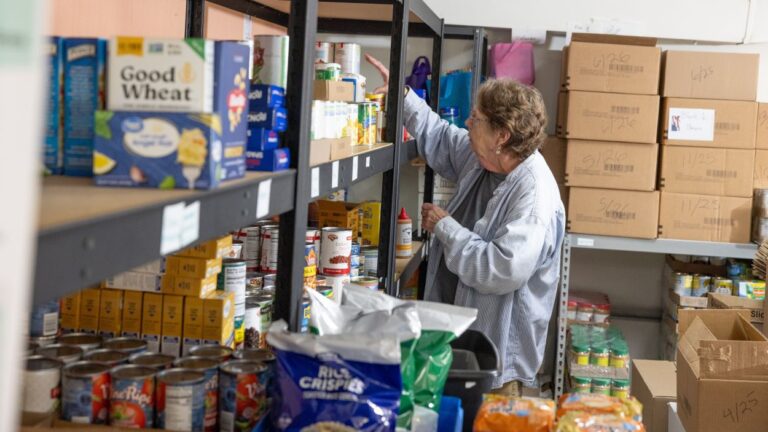Opponents of a bill that would decriminalize possession of small amounts of scheduled drugs say other states that have done so are stuck in a worsening drug crisis brought on by the policy change. But data suggests otherwise.
A bipartisan bill sponsored by Rep. Lydia Crafts (D-Newcastle), L.D. 1975, would repeal sections of a state statute that make possession of small amounts of certain drugs — including heroin, cocaine and fentanyl — a criminal offense. It would also create a fund aimed at improving access to treatment and recovery resources statewide.
Supporters of the bill gave hours of emotional testimony before the Health and Human Services Committee last week. In a direct appeal to his Republican colleagues, one of the bill’s co-sponsors, Rep. Lucas Lanigan of Sanford, recounted how he nearly lost his son, Alex, to substance use disorder.
His son is celebrating 14 months of sobriety thanks to the support of his family, doctors and his own commitment to his recovery, Langian said.
“Most people lack these crucial supports in their recovery. As a state, we have made the entry level back to society so tough that we continue to see failure more often than success,” he said.
Opponents of the bill pointed to states such as Oregon and Washington as examples of why decriminalization would be catastrophic for Maine. Gordon Smith, Gov. Janet Mills’ director of opioid response, said the Mills administration opposes the measure.
Brewer Mayor Jenn Morin told lawmakers an Oregon ballot measure approved by voters in 2021 that changed possession of small amounts of all previously criminalized drugs to a noncriminal violation with a maximum fine of $100 has had “disastrous consequences.”
“Homelessness increased, overdoses increased, crime increased, public disorder increased and social costs increased,” she said.
Opioid overdose deaths in Oregon have skyrocketed, from 280 in 2019 to a high of 956 in 2022, according to the Oregon Health Authority. Some cities, including Portland, are considering rolling back parts of the law amid a proliferation of open-air drug use that has led to heavy criticism from residents and businesses.
But research into the aftereffects of decriminalization in Oregon, and a Washington state Supreme Court ruling and legislative action that partially decriminalized drugs, found no evidence the changes had an effect on drug-related deaths.
“We found that the changes in fatal overdoses that are happening were not due to the policy changes,” said Spruha Joshi, an assistant professor of epidemiology at the University of Michigan and co-author of two research papers that looked into death and arrest rates post-decriminalization.
The increase in Oregon, as is the case for much of the nation, is likely due, at least in part, to the proliferation of fentanyl.
In a peer-reviewed study published in the JAMA Psychiatry, researchers used a method called synthetic control to “emulate a parallel universe” of what Oregon or Washington might look like without decriminalization, said Magdalena Cerdá, the director of the Center for Opioid Epidemiology and Policy at the NYU Grossman School of Medicine.
“Then it compares what happened in Oregon or Washington to what happened in the other states that are most similar to Oregon and Washington. When we did that, we found that actually there was no greater change in overdoses in Oregon and Washington,” compared to those other states, she said.
Overdoses went up sharply around the country in the years following Oregon’s decriminalization, which coincided with the pandemic.
But researchers found the state’s monthly fatal overdose rate per 100,000 people was, on average, just 0.27 points higher than the comparison states. The difference between Washington’s monthly fatal overdose rate and comparison states, including Maine, was even smaller, at just 0.11 more overdoses per 100,000 people.
To be statistically significant, the difference needed to be at least 0.5 overdoses per 100,000 people.
Cerdá said even after accounting for the proliferation of fentanyl in the drug market by comparing fentanyl seizures in Oregon and Washington to the comparison states, “we’re still seeing the same lack of an effect,” of the Oregon law, or Measure 110.
Winifred Tate, director of the Maine Drug Policy Lab at Colby College, said evidence shows “criminalization and punitive drug strategy has created a tremendous amount of suffering in Maine and around the country.”
According to a 2022 report from the Maine Drug Policy Lab, ACLU Maine and the Maine Center for Economic Policy, recent increases to spending on criminalization have “well-outpaced” increases to spending on treatment.
“A year in state prison costs more than twice as much as it would cost to provide housing, weekly counseling and medication-assisted treatment for a year at current MaineCare reimbursement rates,” the report states.
Research published by the Pew Charitable Trusts in 2018 found high rates of drug imprisonment and stiffer sentences did not translate into lower rates of drug use, overdoses and arrests at both the state and federal level.
Maine laws also draw a thin line between “possession,” “furnishing,” and “trafficking,” based on the amount of drugs a person has on them at the time of arrest, which result in increasingly severe criminal violations.
Crafts’ bill would decriminalize possession, which covers only very small amounts of drugs. Under current law a person could be charged with a Class C crime, punishable by up to five years in prison and a $5,000 fine, for possessing 200 milligrams of heroin, oxycodone, methamphetamine or fentanyl. That’s equivalent to the weight of a raindrop, the Maine report notes.
A person could be charged with a Class B crime, which carries a punishment of up to 10 years incarceration and a $20,000 fine, for carrying a sugar packet’s weight worth of crack cocaine.
“Maine laws are incredibly harsh,” Tate said.
Possession of four grams of fentanyl or heroin, the equivalent weight of four paper clips, could result in trafficking charges, also a Class B crime.
“Many of the people who are in active use now will say they are using daily more than these amounts, and they would still be vulnerable to trafficking charges just for possessing the amount they use to maintain their well-being during the day,” Tate said.
Under current law, the Maine report notes that prosecutors and juries are not required to prove intent — whether a person intended to share or sell drugs — to secure a furnishing or trafficking conviction.
That, combined with the fact the vast majority of drug possession cases are resolved through a plea deal to avoid harsher sentences, “show that it is rarely big-time drug sellers who are ensnared by drug trafficking laws.”
“Maine is a state where people are often caught up on trafficking changes and sentenced as traffickers for simply trying to maintain their own habits,” Tate said.







